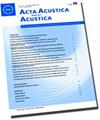高强度航空超声暴露对听觉行为和电生理指标的影响
Q1 Arts and Humanities
引用次数: 8
摘要
关于安全超声暴露限度的规定是基于非常有限的研究,这些研究只考虑了听力阈值变化作为听力缺陷的指标。本研究的目的是评估暴露于高强度超声对一系列听力功能测量的影响,包括听力阈值,以及听力缺陷的亚临床测量:噪音中的言语理解,超阈值听觉脑干反应波I振幅和潜伏期,以及对调幅(AM)音调的频率响应水平。在一组9名年轻听众的左耳暴露于高强度超声之前和之后,评估了这些指标的变化。研究人员将这些变化与由9名年轻听众组成的对照组进行了比较。暴露包括在105,110,115和120db声压级下呈现40khz AM音调10分钟,再加上在超声检测任务期间暴露于40khz未调制的音调,总持续时间为50秒。没有一项听力功能的测量结果显示,与右耳相比,左耳的变化更大,与对照组相比,暴露组的参与者的变化也更大。在暴露于AM音调期间获得的脑电图记录在超声音调的调制频率或低频次谐波处没有显示显着的锁相活动。九分之一的参与者能够执行高于机会水平的超声波检测任务,尽管由于实验设置的限制,她可以检测音调呈现的机制尚不清楚。本文章由计算机程序翻译,如有差异,请以英文原文为准。
Effects of High-Intensity Airborne Ultrasound Exposure on Behavioural and Electrophysiological Measures of Auditory Function
Regulations on safe ultrasound exposure limits are based on a very limited number of studies, which have only considered audiometric threshold shifts as indicators of hearing deficits. The purpose of the current study was to assess the effects of exposure to high-intensity ultrasound
on a range of measures of hearing function, which included audiometric thresholds, as well as subclinical measures of hearing deficits: speech-in-noise understanding, supra-threshold auditory brainstem response wave I amplitude and latency, and frequency following response levels to amplitude
modulated (AM) tones. Changes in these measures were assessed before and after exposure of the left ear to high-intensity ultrasound in a group of nine young listeners. These changes were compared to those observed in a control group of nine young listeners. Exposure consisted in the presentation
of a 40-kHz AM tone at levels of 105, 110, 115, and 120 dB SPL for 10 minutes at each level, plus an exposure to a 40-kHz unmodulated tone during an ultrasound detection task, for a total duration of 50 seconds. None of the measures of hearing function was found to change significantly more
for the left compared to the right ear, for participants of the exposure group compared to control participants. Electroencephalographic recordings obtained during exposure to the AM tone did not show significant phase-locked activity at the modulation frequency or at low-frequency subharmonics
of the ultrasound tone. One out of nine participants was able to perform the ultrasound detection task above chance level, although due to limitations of the experimental setup the mechanism by which she could detect the presentation of the tone remains unclear.
求助全文
通过发布文献求助,成功后即可免费获取论文全文。
去求助
来源期刊
CiteScore
2.60
自引率
0.00%
发文量
0
审稿时长
6.8 months
期刊介绍:
Cessation. Acta Acustica united with Acustica (Acta Acust united Ac), was published together with the European Acoustics Association (EAA). It was an international, peer-reviewed journal on acoustics. It published original articles on all subjects in the field of acoustics, such as
• General Linear Acoustics, • Nonlinear Acoustics, Macrosonics, • Aeroacoustics, • Atmospheric Sound, • Underwater Sound, • Ultrasonics, • Physical Acoustics, • Structural Acoustics, • Noise Control, • Active Control, • Environmental Noise, • Building Acoustics, • Room Acoustics, • Acoustic Materials and Metamaterials, • Audio Signal Processing and Transducers, • Computational and Numerical Acoustics, • Hearing, Audiology and Psychoacoustics, • Speech,
• Musical Acoustics, • Virtual Acoustics, • Auditory Quality of Systems, • Animal Bioacoustics, • History of Acoustics.

 求助内容:
求助内容: 应助结果提醒方式:
应助结果提醒方式:


